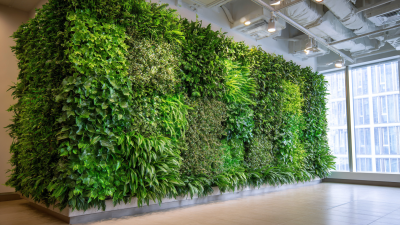Transforming your outdoor space with Artificial Green Grass has become increasingly popular, with the global artificial turf market projected to reach $3.9 billion by 2024, according to a report by Research and Markets. As homeowners increasingly seek sustainable landscaping solutions, Artificial Green Grass presents a low-maintenance and eco-friendly alternative to traditional grass. Unlike natural lawns, which require constant watering, mowing, and fertilizing, artificial grass offers a vibrant, green look year-round without the environmental impact.

Additionally, the outdoor living trend has propelled interest in creating inviting, aesthetically pleasing spaces, making Artificial Green Grass a perfect solution for patios, backyards, and even indoor areas. In this step-by-step tutorial, we'll guide you through the transformation process, ensuring that your outdoor space is both beautiful and functional.
When transforming your outdoor space, selecting the right type of artificial grass is crucial for achieving a lush, low-maintenance environment. According to recent industry insights, modern artificial grass has improved significantly in quality, with some products being so realistic that they can easily be mistaken for natural lawns. Homeowners report a decrease in upkeep by over 50% when opting for synthetic grass, eliminating the need for time-consuming tasks like mowing and reseeding.
Moreover, when choosing artificial grass, consider factors such as durability, foot traffic suitability, and pet-friendliness. Recent reviews highlight options specifically designed for households with pets, ensuring both resilience and comfort. Additionally, the best types of artificial grass cater to various climates and sunlight conditions, with some even holding color and structural integrity for years. With the right choice, you can create a vibrant outdoor area that complements your lifestyle while conserving water and reducing maintenance efforts.
| Type of Artificial Grass | Pile Height (inches) | Color Blend | Durability (Years) | Ideal Use |
|---|---|---|---|---|
| Luxury Turf | 1.5 | Dark Green with Brown Thatch | 15-20 | Residential Lawns |
| Pet Friendly Grass | 1.25 | Bright Green | 10-15 | Dog Runs, Play Areas |
| Landscape Turf | 2.0 | Multi-Color Blend | 12-18 | Golf Courses, Decorative Areas |
| Putting Green Turf | 0.5 | Deep Green | 10-15 | Backyard Putting Greens |
| Playground Grass | 1.5 | Light Green | 8-12 | Playgrounds, Safe Areas |
To transform your outdoor space with artificial green grass, the first crucial step is to prepare the area properly. Start by clearing the ground of any debris, rocks, and old grass. According to a report by the Synthetic Turf Council, proper ground preparation can increase the longevity of your artificial grass by 50%. It prevents underlying issues such as weed growth and drainage problems, which are often overlooked.
Next, leveling the ground is essential for a seamless installation. Ensure that the surface is flat and even, using a rake to spread the soil. This process not only aids in the aesthetic appeal of your outdoor space but also ensures that water drains correctly, reducing the risk of pooling. In fact, a well-leveled surface can minimize maintenance efforts by up to 30%, as noted in industry studies focusing on turf care.
Tips: Always check for any slopes in your design; a slight incline can help with drainage. Additionally, consider using a compactor to solidify the ground before laying your grass, which will contribute to a more stable foundation. Regularly monitor the installed area to adjust any uneven spots that may cause wear over time.
When you're ready to transform your outdoor space with artificial green grass, having the right tools and materials is crucial for a smooth installation. Begin with quality artificial turf suitable for your climate and intended use; consider options with UV protection to enhance durability. Additionally, you'll need a landscape fabric to prevent weeds from poking through, along with infill material such as sand or rubber granules to provide stability and cushioning.
In terms of tools, a utility knife will be essential for cutting the grass to fit your area precisely. A power roller or a weighted lawn roller helps in firmly securing the turf down and ensuring a smooth finish. Don’t forget the adhesive or seams tape if you are joining multiple pieces of turf.
Tip: Before starting, measure your area accurately and plan your layout. It can save time and materials, ensuring a professional-looking installation. Additionally, consider using a knee pad while working to protect your knees, as you'll likely be on the ground for extended periods. With the right tools and a solid plan, you can create a lush, green outdoor space that will provide enjoyment for years to come.
Transforming your outdoor space with artificial green grass can significantly enhance its appeal and functionality. Installing artificial grass is a straightforward process when you follow a step-by-step approach. Start by measuring the area you want to cover and ensure you order enough grass to fit the space. Next, remove any existing grass or debris, leveling the ground to create a smooth surface. Adding a layer of crushed stone or gravel helps with drainage and provides a solid foundation for the grass.
Once the ground is prepped, lay down a weed barrier to prevent any unwanted growth beneath your new grass. It's now time to roll out the artificial grass, aligning the edges to minimize seams. Secure the grass in place with landscape staples or adhesive, ensuring it adheres well to the substrate. After cutting any excess edges for a clean fit, brush the grass fibers against the grain to make it look natural. Finally, apply infill material to help maintain the grass's upright position and improve drainage. With these steps, your outdoor space will be transformed into a lush, green haven that requires minimal maintenance.

Maintaining your artificial grass is essential for ensuring its longevity and aesthetic appeal. According to the Synthetic Turf Council, properly maintained artificial lawns can last between 15 to 25 years. Regular upkeep not only preserves the vibrant look of your green space but also enhances its functionality, making it safe and enjoyable for various activities.

One of the key maintenance tips is regular brushing. This helps to keep the fibers standing upright, preserving the grass's natural appearance. Weekly brushing with a stiff-bristle broom can help avoid matting, particularly in high-traffic areas. Additionally, using a leaf blower or a vacuum designed for artificial turf can efficiently remove debris, preventing the buildup of organic matter that can lead to odors or pest issues.
Another crucial aspect of maintenance is proper infill replenishment. Infill serves multiple purposes: it provides cushioning, keeps the grass upright, and helps with drainage. The Synthetic Turf Council recommends checking your infill levels periodically and adding new material when necessary to maintain the optimal depth—typically around ½ to 1 inch. This ensures your artificial grass remains functional and continues to look its best over time.












